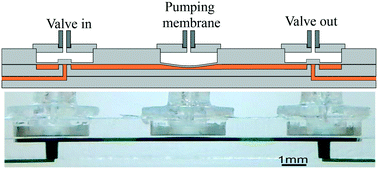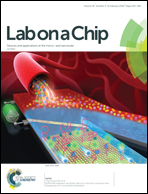Pressure-actuated monolithic acrylic microfluidic valves and pumps†
Abstract
In this article, we describe a microfluidic device with embedded valves and pumps made exclusively of layers of acrylic glass. Flat acrylic sheets are carved out with a micromilling machine and bonded together by solvent bonding. The working principle of the valves is based on a thin flexible membrane (≈100 μm) machined on one acrylic sheet and actuated with pneumatic pressure. A completely closed valve resists a pressure difference of ≈17 kPa (≈2.5 psi), and when open, it can sustain flow rates of up to 100 μL s−1. Pumping is achieved by combining two valves and a pumping chamber in series, which is also based on the bending of a thin acrylic membrane. The maximum flow rate obtained with this pumping mechanism is 20 μL min−1. Acrylic is a popular rigid thermoplastic because it is inexpensive, making it ideal for mass production of disposable devices, and also because it has demonstrated compatibility with different biochemical assays. The physical and optical properties it shares with other thermoplastics could lead to this material being implemented for similar valves and pumps. As a proof-of-concept of our technology, we implemented a controlled cell-staining assay in two parallel incubation chambers integrating four valves and one pump into one device. Our monolithic acrylic valves can enable the mass production of disposable microfluidic devices that require fluid control with pressure-actuated valves and aid in the automation of biochemical assays.



 Please wait while we load your content...
Please wait while we load your content...